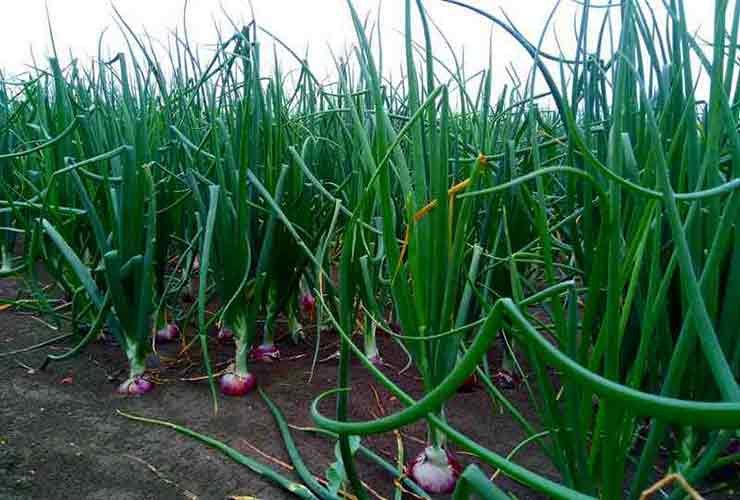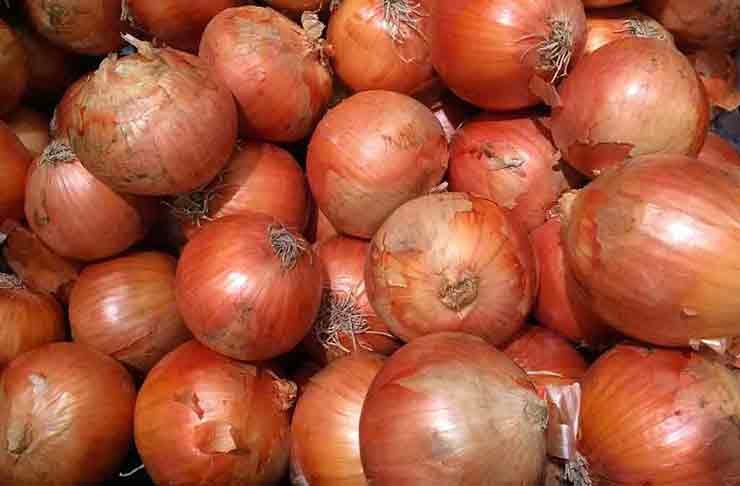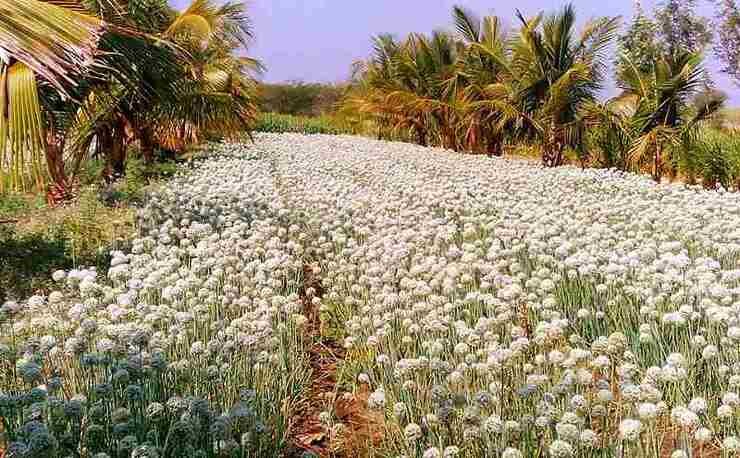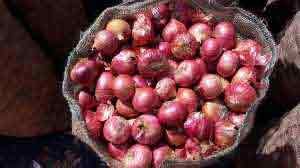Onion cultivation is a very profitable business. Onion plant can be cultivated as a monocrop or intercrop. Here is the complete guidance on onion farming including onion growing conditions, season, seeds, diseases and harvesting.
Globally, China, India and US are the largest producers of onions with India being the second largest producer of onion. Indian onions have two crop cycles with the first onion harvesting during November to January months and second during January to May months. Hence, onion is available throughout the year in India.
Information on Onion
Botanical name for onion is Allium cepa– belonging to Liliaceae family. Its closest relatives are shallots, garlic and leeks. It is a bulbous plant with the bulbs being produced annually. The leaves are semi-cylindrical or tubular in structure. They have a waxy coating on the surface and emerge from a subterranean bulb that bears short, branched roots. The stem grows upto 200 cm in height. Flowers appear at the tip of the stem and are greenish-white in color. The bulb has several layers of overlapping surfaces around a central core and it can expand upto 10 cm in diameter.
Ideal Conditions for Onion Cultivation
Onion needs a temperate climate and alluvial soil to grow in. Depending on the onion growing time and place of cultivation, onion can be grown as long day onions (for plains) or short day onions (ideal for hilly regions).

Climate for Onion Farming
Although it is a temperate crop, onion cultivation can be possible under sub-tropical, temperate or tropical climate. A mild, gentle weather that is not too rainy, too cold or too hot is ideal for onion growing. However, it can withstand extreme weather conditions at younger stage. Short day onions that need 10-12 hours of day length are grown in plains while long day onions requiring 13-14 hours of day length are grown in the hilly areas.
Onion crops need lower temperature and shorter day light (photoperiod) for vegetative growth while during the bulb development and maturity stage it needs a higher temperature and longer day light. Other requirements for onion cultivation are:
| Temperature | Vegetative phase- 13-24⁰C Bulb development phase- 16-25⁰C |
| Relative Humidity | 70% |
| Average annual rainfall | 650-750 mm |
Season for Onion Farming
In India, onions are cultivated both as kharif and rabi crop. This is because onions are grown in almost all the Indian states. The time and season of onion cultivation depends on the geographical location and weather at the particular place. Here is a table containing the time of cultivation and harvesting in different places of cultivation in India:
| Place | Season | Time of Sowing | Time of Harvest |
|---|---|---|---|
| Hilly Areas | Rabi | September- October | June- July |
| Summer | November- December | August- October | |
| Punjab, Haryana, UP, Bihar, Rajasthan | Kharif | June- July | October- November |
| Rabi | October- November | May-June | |
| Orissa and West Bengal | Kharif | June- July | November- December |
| Late Kharif | August- September | February- March | |
| Rabi | September- October | March- April | |
| Maharashtra and parts of Gujarat | Early Kharif | February- March | August- September |
| Kharif | May- June | October- December | |
| Late Kharif | August- September | January- March | |
| Rabi | October- November | April- May | |
| Andhra Pradesh, Tamil Nadu, Karnataka | Early Kharif | February- April | July- September |
| Kharif | May- June | October- November | |
| Rabi | September- October | March- April |
Soil for Onion Cultivation in India

Onions can be grown in all types of soils such as heavy soil, clayey soil, sandy loam, etc. However, red to black loamy soil with good drainage capacity is ideal for onion cultivation. The soil must be friable, have good moisture holding capacity as well as enough organic matter. Although onions can be grown in heavy soils it must have a good amount of organic matter. Hence applying manure (farm yard or poultry) at the time of field preparation in case of heavy soil onion cultivation is important. In addition, onions cannot survive in saline, acidic or alkaline soils.
pH for Onion Growing
Soil with neutral pH (6.0 to 7.0) is optimal for onion cultivation. It can tolerate mild alkalinity (pH upto 7.5). They cannot survive if the soil pH drops below 6.0 owing to aluminum or manganese toxicity or trace element deficiency.
Water for Growing Onions
Onion crop irrigation depends on the season of planting, type of soil, irrigation method and age of the crop. Generally, irrigation is done at the time of seedling plantation, during transplantation period, 3 days after transplantation and subsequently at regular intervals depending on the moisture content in soil. The last irrigation is done 10 days before harvesting onion. Being a shallow-rooted crop, onions need small amounts of irrigation at regular intervals. This helps maintain optimal soil temperature and moisture for growth and bulb development. Excess irrigation followed by dry spell would result in bolter formation and splitting of outer scales. Modern irrigation techniques like drip and sprinkler irrigation are used as they help prevent excess water loss. These techniques help maintain the ideal moisture level in soil. In addition, dispensing water through drip or sprinkler emitter would ensure water at the root of the plant. It prevents water seepage into the soil and thus water loss to a great extent.
Intercropping in Onion Cultivation
Onion being shallow-rooted is suitable for intercropping. In other words, two or more crops can be grown together. However it also depends on location, nature of soil and climatic conditions. The main idea of inter-cropping is to use the resources effectively and gain a great yield without causing any harm to the main crop. If onion is planted as rabi crop then it can be paired with sugarcane. For this, furrows and ridges are prepared for sugarcane. After two rows of sugarcane, a flatbed for onion is prepared. Both onion seedling and sugarcane is planted simultaneously. This type of planting under drip irrigation helps save 25-30% water.
Crop Rotation with Onion Farming
Being a shallow rooted crop efficient and optimal utilization of all the applied soil mineral nutrients is unlikely. The unused nutrients would leach down and settle in the sub-soil. In the next growing season, planting leguminous crops would ensure utilization of these nutrients. Thus, onion and legume cultivation sequence is recommended for maintaining soil health, optimum nutrient utilization and higher yield.
Planting Material for Onion Cultivation
Since cultivation of onion is influenced by a variety of factors like temperature, photoperiod, weather, etc. research institutes have developed different varieties suitable for particular seasons and regions. The commercially grown variety is classified into 3 groups as White, Yellow and Red. Here is a list of different varieties developed by various research institutes:
White Varieties
| Name of Variety | Centre to Develop | Characteristic | Yield (Quintal per Hectare) | Resistance | Season of Growth |
|---|---|---|---|---|---|
| Pusa White round | ICAR-IARI, New Delhi |
| 300 | ||
| Pusa White flat | ICAR-IARI, New Delhi |
| |||
| Bhima Shweta | ICAR-DOGR, Pune |
| 350 | Tolerant to thrips | Rabi |
| Bhima Shubra | ICAR-DOGR, Pune |
| 240 (Kharif) 380 (late Kharif) | Tolerant to environmental fluctuations | Kharif and Late Kharif |
| Agrifound White | NHRDF, Nasik |
| 200-250 | ||
| Punjab-48 (S-48) | PAU, Ludhiana |
| |||
| Punjab White | PAU, Ludhiana |
| 250-300 | ||
| N-257-9-1 | MPKVP, Rahuri |
| Rabi | ||
| Udaipur-102 | MPUAT, Udaipur |
| 300-350 |
Yellow Color Varieties
| Name | Centre | Characteristics | Yield (Quintal per hectare) | Resistance to | Season of Growth |
|---|---|---|---|---|---|
| Early Grano | ICAR- IARI, New Delhi |
| 300-350 | ||
| Brown Spanish | ICAR-IARI, Regional Station, Katrain |
| 250-300q/ha. | ||
| Arka Pitamber | ICAR-IIHR, Bengaluru |
| |||
| Phule Swarna | MPKVP, Rahuri |
| 240q/ha. |
Red Color Varieties
| Name of Variety | Center | Special Characteristics | Yield (quintal per hectare) | Resistance to | Season of Growth |
|---|---|---|---|---|---|
| Pusa Red | ICAR- IARI, New Delhi |
| 250-300q/ha. | ||
| Pusa Ratnar | ICAR- IARI, New Delhi |
| 300-400q/ha | ||
| Pusa Madhavi | ICAR-IARI, New Delhi |
| 300q/ha. | ||
| Pusa Ridhi | ICAR-IARI, New Delhi |
| 310 | Both kharif and rabi | |
| Arka Pragati | ICAR-IIHR, Begaluru |
| 200 | Kharif and Rabi | |
| Arka Niketan | ICAR-IIHR, Bengaluru |
| |||
| Arka Kalyan |
| 335 | Purple blotch | Kharif | |
| Arka Bindu | ICAR-IIHR, Bengaluru |
| 250 | ||
| Bangalore Rose | ICAR-IIHR, Bengaluru |
| 150 | ||
| Arka Lalima(F1) | ICAR-IIHR, Bengaluru |
| 500 | Biotic stress | |
| Arka Kirtiman | ICAR-IIHR, Bengaluru |
| 300-375 | Can withstand biotic stress | |
| Bhima Raj | ICAR-DOGR, PUNE |
| 250-300 | Rabi | |
| Bhima Red | ICAR-DOGR, PUNE |
| 480-520 | Kharif Late Kharif Rabi (must be immediately marketed) | |
| Bhima Super | ICAR-DOGR, PUNE |
| 260-280 during kharif and 400-450 during late kharif | Kharif Late kharif | |
| Bhima Kiran | ICAR-DOGR, PUNE |
| 410 | Rabi | |
| Bhima Shakti | ICAR-DOGR, PUNE |
| 420-450 | Thrips | Late kharif and rabi |
Land Preparation for Onion Farming
Onion can grow in almost all types of soils. Generally, the seeds are sowed in nursery and the seedlings are transplanted after approximately 30-40 days. Before transplantation the field must be ploughed properly to get rid of the soil clods and unwanted debris. Vermicomposting (approximately 3 tonnes per acre) or poultry manure can be incorporated. This is done during the last ploughing.
After ploughing the fields are levelled and beds are prepared. Depending on the season, the beds maybe flat beds or broad bed furrows. Flat beds are 1.5-2 meter in width and 4-6 meter in length. Broad bed furrows have a height of 15 cm and top width of 120 cm. The furrows are 45 cm deep so as to get the right spacing. Onions are cultivated in broad bed furrows during kharif season since it is easier for excess water to drain out through the furrows. It also facilitates aeration and reduces occurrence of Anthracnose disease. Flat beds are made if onion cultivation is done during rabi season. Flat beds for kharif can cause water logging.
Planting Onion
Onion seeds are first sown in nurseries and later transplanted to the open fields. Nursery management and transplanting are hence the most important steps in onion cultivation.
Nursery Management

For one acre of onion plantation, seedlings can be prepared in 0.12 acre of area. The nursery field must be ploughed well and made free of clods. The soil must be reduced to finer particles so as to hold enough water. The filed must be clear of stones, debris and weeds. Just like the main field preparation, farm yard manure (half ton) must be applied at the time of last ploughing. Raised beds are recommended for nursery preparation. This is because flat beds allow water movement from end to end. There is a risk of seeds getting washed away in the process. The beds must be raised to a height of 10-15 cm, width of 1 m and length as per convenience. Keep a distance of at least 30 cm between the beds to allow easy drainage of excess water. 0.2% Pendimethalin is used for controlling the weeds in the nursery. 2-4 Kg of seeds is required for one acre of onion cultivation.
Seed Preparation
Seeds are treated with 2g/Kg of thiram or Trichoderma viride to prevent damage from damping off diseases. The seed distance is maintained at 50-75mm to facilitate easy weeding and removal of seedlings for transplantation. The seeds are covered with farm yard manure after sowing and watered slightly.
Transplantation
Onion seeds are first grown in nurseries and then the seedlings are transplanted to the fields 30-40 days later. 3-4 Kg seeds are needed for one acre of field. Early transplantation yields more bulbs. During transplantation, care must be taken to avoid over and under-aged seedlings. The following process is followed during transplantation:
- About one-third of the top of the seedling is cut
- Roots are dipped in 0.1% carbendazim solution for two hours to prevent fungal diseases
- The seedlings are transplanted into prepared beds at a distance of 10 cm between plants.
The transplantation schedules for onion crop at different locations are as below:
| Place | Season | Time of Sowing | Time of Transplantation |
|---|---|---|---|
| Hilly Areas | Rabi | September- October | October- November |
| Summer | November- December | February- March | |
| Punjab, Haryana, UP, Bihar, Rajasthan | Kharif | June- July | July- August |
| Rabi | October- November | December- January | |
| Orissa and West Bengal | Kharif | June- July | August- September |
| Late Kharif | August- September | October- November | |
| Rabi | September- October | November- December | |
| Maharashtra and parts of Gujarat | Early Kharif | February- March | April- May |
| Kharif | May- June | July- August | |
| Late Kharif | August- September | October- November | |
| Rabi | October- November | December- January | |
| Andhra Pradesh, Tamil Nadu, Karnataka | Early Kharif | February- April | April- June |
| Kharif | May- June | July- August | |
| Rabi | September- October | November- December |
Diseases and Plant Protection in Onion Farming
Onions suffer from a number of diseases caused by fungi, bacteria, nematodes and insects. Some major ones are as below:
Viral Diseases
| Disease Name | Virus Name | Symptoms and Nature of Damage | Spread of Disease | Control Measures |
|---|---|---|---|---|
| Onion Yellow Dwarf | Onion Yellow Dwarf Virus |
| Spread mainly through aphids |
|
| Irish Yellow Spot | Irish Yellow Spot Virus |
| Thrips |
|
Fungal Diseases
| Disease Name | Causative Agent | Symptoms and Nature of Damage | Spread | Control Measures |
|---|---|---|---|---|
| Damping Off | Water soaking |
|
| |
| Stemphylium blight | Stemphylium vesicarium |
| Spaying fungicides like 0.25% Mancozeb, 0.1% Tricyclazole, 0.1% Hexaconazole or 0.1% Propiconazole every 10-15 days interval starting from 30 days after transplanting or as soon as disease appears. | |
| Purple Blotch | Alternaria porri |
| Spaying fungicides like 0.25% Mancozeb, 0.1% Tricyclazole, 0.1% Hexaconazole or 0.1% Propiconazole every 10-15 days interval starting from 30 days after transplanting or as soon as disease appears. | |
| Anthracnose (twister disease) | Colletotrichum gleosporiodes |
|
|
Insect Diseases
| Pest Name | Identification | Symptoms and Nature of Damage | Control Measures |
|---|---|---|---|
| Thrips (Thrips tabaci) |
|
|
|
| Eriphyid mites |
|
|
|
Onion Harvesting
Onion harvesting is done when the still green tops start drooping. The plants are gently pulled out from the soil. However, 10-15 days before harvesting irrigation of the field is stopped. The crop is also sprayed with 1000 ppm carbendazim 30 days before harvest. This helps increase the shelf-life of the crop. The bulbs are cleaned and dried in shade for 4 days.
Onion Grading
After harvesting, the bulbs are graded according to their size as A (more than 80mm), B (50-80 mm) and C (30-50 mm). In India, this is done manually as well as via machines.
Onion Storage

Generally, onion bulbs harvested in rabi season have better shelf-life than kharif. Light red onion varieties have better storage potential than the dark red varieties. They are stored in jute bags or wooden baskets. They are also stored in netted bags. This is important because onions emit gas which if may lead to rotting if not allowed to escape. Optimum temperature for storage is 30-35˚C with 65-70% relative humidity.
Cold storage increases the shelf life. The loss of crop after storing in cold for six months has been found to be 5%. However, extremely low temperature (less than -2⁰C) can lead to freezing injury. A high temperature can cause rotting. A gradual decrease of temperature prevents microbial decay.
Conclusion
In the recent years India faces a shortage in onion on a yearly basis and this triggers price rise. Therefore, onion cultivation can be a huge money making agribusiness.
Reference
- http://apeda.gov.in/apedawebsite/SubHead_Products/Onions.htm
- https://en.wikipedia.org/wiki/Onion
- http://www.centerchem.com/Products/DownloadFile.aspx?FileID=6784
- http://dogr.res.in/index.php/en/onion
- http://agritech.tnau.ac.in/horticulture/horti_vegetables_small%20onion.html
- http://www.krishisewa.com/crop_system/varieties/vegetable-varieties/596-varieties-onion.html
- http://vikaspedia.in/agriculture
Can i please have the best variety of onion seeds for farming
Thank u for the valuable information…
So elaborately detailed, this topic will surely benefit our farmers. Thank you Dr. Indira, for such a nice topic.
I am from Arunachal Pradesh, wish to cultivate this crop(onion) and this kharif season itself as late kharif crop with var.- Bhima Sakti and/or Bhima Super. I would be grateful if you would be kind enough to extend your guidances, please.
I am in Botswana where the temperature semi arid, I would like to know the type of onion to plough in this climate. I would like to know how to plough onions.
I am interested in onion farming in Rajasthan (Distt Alwar) at my farm. Need further guidance. Is it possible to sow/plant now (today is November 11, 2020)?
Please guide.
I want onion summer crop , summer best varieties in form
I am vijay mhaske from Nashik ,
Dear madam/sir you have so elaborately detailed this topic and will surely benefit me and our farmers. Thank you for such a nice topic may i have a project report on onion farming
Good agronomic guides for farmers for higher yields, more is required. Thanks